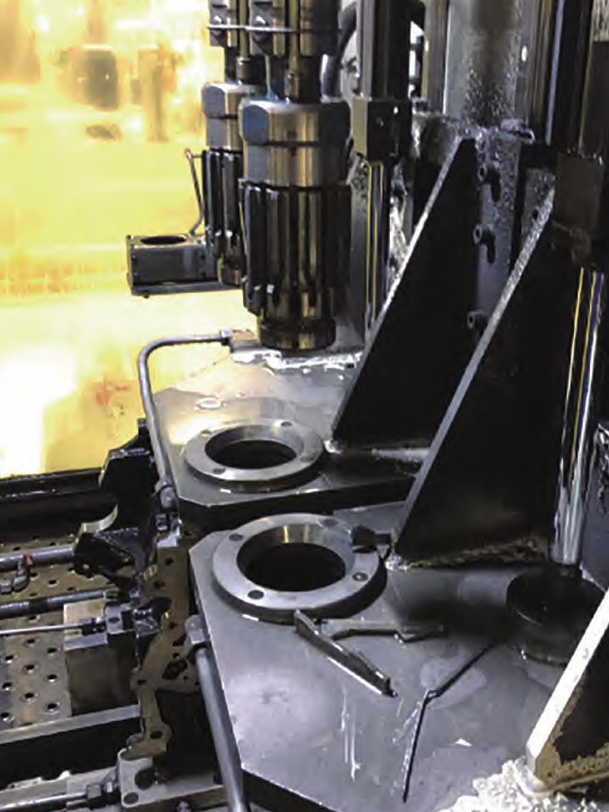Casting defects significantly impact the quality and reliability of critical components in high-speed rail systems. This article systematically examines various casting defect types through metallurgical analysis and mechanical evaluations, while proposing mathematical models to quantify their effects on component performance.

1. Fundamental Mechanisms of Casting Defect Formation
The formation of casting defects can be mathematically described using solidification dynamics. The Niyama criterion predicts shrinkage porosity through the equation:
$$N_y = \frac{G}{\sqrt{\dot{T}}}$$
where \(G\) represents temperature gradient (K/m) and \(\dot{T}\) denotes cooling rate (K/s). Defects occur when \(N_y\) falls below critical thresholds.
| Defect Type | Formation Mechanism | Critical Niyama Value |
|---|---|---|
| Shrinkage Porosity | Insufficient liquid metal feeding | ≤ 1.0 |
| Hot Tearing | Thermal stress concentration | N/A |
| Cold Shut | Premature solidification fronts | N/A |
2. Quantitative Analysis of Casting Defect Impacts
The stress concentration factor (\(K_t\)) for surface defects can be expressed as:
$$K_t = 1 + 2\sqrt{\frac{a}{\rho}}$$
where \(a\) is defect depth and \(\rho\) represents root radius. For subsurface defects, the modified Peterson equation applies:
$$K_t = 1 + \frac{0.9}{\sqrt{1 + \frac{2.5}{d/a}}}$$
where \(d\) denotes distance from surface.
3. Metallurgical Characteristics of Casting Defects
| Defect Category | Microstructural Features | Hardness Reduction (%) |
|---|---|---|
| Pre-existing Crack | Oxide inclusions along crack path | 18-22 |
| Shrinkage Porosity | Dendritic segregation patterns | 25-30 |
| Cold Shut | Columnar grain discontinuity | 30-35 |
4. Heat Treatment Induced Defect Propagation
The Johnson-Mehl equation describes phase transformation kinetics:
$$X = 1 – \exp(-kt^n)$$
where \(X\) is transformed fraction, \(k\) the rate constant, and \(n\) the Avrami exponent. Improper heat treatment parameters accelerate casting defect growth through:
$$ \frac{da}{dN} = C(\Delta K)^m $$
where \(da/dN\) is crack growth rate, \(\Delta K\) stress intensity range, and \(C\), \(m\) material constants.
5. Welding Repair Challenges for Casting Defects
The dilution ratio during weld repair significantly affects defect elimination efficiency:
$$D = \frac{A_m}{A_m + A_w} \times 100\%$$
where \(A_m\) is melted base metal area and \(A_w\) filler metal area. Optimal repair requires maintaining 20-30% dilution ratio to prevent casting defect regeneration.
| Repair Parameter | Optimal Range | Defect Recurrence Probability |
|---|---|---|
| Heat Input (kJ/mm) | 1.2-1.8 | ≤5% |
| Interpass Temp (°C) | 150-200 | ≤8% |
| Post-Weld HT | 620±15°C | ≤3% |
6. Fatigue Performance Degradation Models
The Paris-Erdogan law quantifies casting defect growth under cyclic loading:
$$ \frac{da}{dN} = C(\Delta K)^m $$
where:
- \(C = 1.35 \times 10^{-10}\) (MPa√m)-m
- \(m = 3.2\) (for ferritic-pearlitic steels)
- \(\Delta K = 12-25\) MPa√m
Experimental data shows components with casting defects exhibit 40-60% reduction in fatigue life compared to defect-free specimens.
7. Advanced Detection Thresholds
Current NDT capabilities for casting defect detection:
| Method | Minimum Detectable Size | Probability of Detection |
|---|---|---|
| Phased Array UT | 0.3mm | 98.7% |
| DR Radiography | 1% wall thickness | 95.2% |
| Eddy Current | 0.5mm surface | 89.5% |
The statistical probability of casting defect detection follows:
$$P_d = 1 – \exp\left(-\frac{A}{A_0}\right)$$
where \(A\) is defect area and \(A_0\) reference detection threshold.
8. Preventive Strategies and Process Optimization
Implementing Six Sigma methodology reduces casting defect rates through:
$$DPMO = \frac{\text{Number of defects} \times 10^6}{\text{Number of opportunities}}$$
Process capability index targets:
$$C_{pk} = \min\left(\frac{USL – \mu}{3\sigma}, \frac{\mu – LSL}{3\sigma}\right) \geq 1.67$$
Advanced simulation techniques enable casting defect prediction accuracy exceeding 92% through multi-physics modeling:
$$\nabla \cdot (\rho \mathbf{u}) = 0$$
$$\rho (\mathbf{u} \cdot \nabla) \mathbf{u} = -\nabla p + \mu \nabla^2 \mathbf{u} + \mathbf{F}$$
This comprehensive approach significantly reduces casting defect occurrence while improving component reliability in high-speed rail applications.
